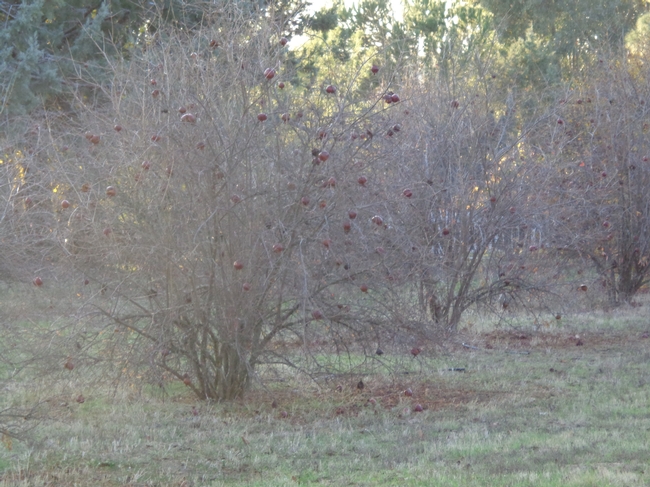Pomegranates
Pomegranates originated about 4000 years ago in Persia and spread from there into northern India. Their cultivation reached throughout the Mediterranean, into Africa and Asia. Ancient mythological stories and the Bible mention pomegranates. Some believe that it wasn't an apple that Eve ate, but a pomegranate. Growing best in climates with hot, dry summers and cool winters, it is easy to see how early California settlers from Spain thought to bring them here to grow in the late 1700s.
Pomegranate trees grow in well-drained soil and can be planted in containers. These deciduous trees seem to do best in slightly alkaline soil. Trees can reach 30 feet in the ground, but more often grow about half that height. Mid-summer pruning can keep them at about 6 feet. Ornamental dwarf varieties also produce fruit, but it is usually dry and inedible. I have even seen some trees with hanging fruit that were bonsaied. Since the trees often sucker at the base, some look more like shrubs. The branches are spiny. The leaves are narrow, shiny and leathery. Flowers arrive first in the spring in red or white or can be variegated. Most varieties are self-fruiting, meaning the bees do the work. The fruit ripens about 6 – 7 months after flowering, usually from September through December. Ripe fruit can be orange to deep red depending on variety. Don't pick it early – it won't ripen any more once it is removed from the tree. To test for ripeness, tap it with your finger. If you hear kind of a metallic sound, it's ripe. If it feels heavy for its size, it is likely juicy.
The arils, AKA seeds, of the edible varieties are ruby red and sweet-tart in contrast to the white surrounding membrane which is bitter. The easiest way to get the seeds out is to lay the fruit on its side and cut it in half. Turn it so that the seeds are facing up and make slits with the knife around the edge of the pomegranate around the lobules that hold the arils. (There are usually 4 or 5 lobules.) Put the half-pomegranate face down in a pot. Using the blunt head of a wooden spoon, give the entire half a solid pounding. This often flattens the pomegranate-half, but when you flip it over, most of the arils are now in the pot. Pick the few out that are left in the pomegranate membrane. This method keeps the juice, which can stain, from flying everywhere. It's a lot faster than individually picking out the arils, too. There are on average 800 arils per fruit.
There are over a dozen varieties of pomegranate trees available, but the most commonly-found is “Wonderful”. Trees will usually produce fruit after 2 or 3 years and can last up to 200 years, but productivity decreases after around 15 years. The trees tolerate drought once established requiring only a good soaking every 2 or 3 weeks. Even the fruit, if refrigerated will last 3 months. What a great addition to your edible garden!
(Pictures of my neighbors' pomegranate orchard)

photo by Michelle Davis

